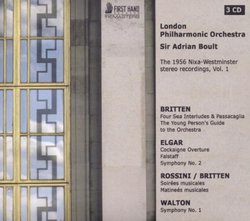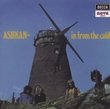| All Artists: London Philharmonic Orchestra, Boult Title: 1956 Nixa-Westminster Stereo Recordings 1 Members Wishing: 0 Total Copies: 0 Label: First Hand Original Release Date: 1/1/2010 Re-Release Date: 6/8/2010 Album Type: Import Genre: Classical Style: Number of Discs: 3 SwapaCD Credits: 3 UPC: 5060216340012 |
Search - London Philharmonic Orchestra, Boult :: 1956 Nixa-Westminster Stereo Recordings 1
 | London Philharmonic Orchestra, Boult 1956 Nixa-Westminster Stereo Recordings 1 Genre: Classical
|
Larger Image |
CD DetailsSimilar CDs
|
CD ReviewsPress Reviews Pianorama | UK | 06/15/2010 (5 out of 5 stars) "International Record Review:
An outstanding set from First Hand Records includes all the British repertoire recorded by Adrian Boult in stereo for Westminster/Nixa, at sessions in Walthamstow Town Hall during August 1956 with the London Philharmonic Orchestra. Some of these performances have been around on CD before, but they have never sounded anything like as resplendent as they do here. For the source material, First Hand Records has gone back to the original Westminster master tapes, and the results are a revelation. In my last roundup (April 2010) I was very enthusiastic about a Somm reissue of Walton's First Symphony and Belshazzar's Feast, and this remains very desirable for the Belshazzar that was made only in mono, but a direct comparison of the two transfers of the First Symphony reveals that the FHR version has a richness, focus and depth of perspective that makes this immensely satisfying performance even more thrilling - it is as if a gauze has been lifted, and the results are nothing short of marvellous. The opening of the first movement is a case in point: on the FHR transfer there's much greater detail in the sound (the energy in the string figurations becomes palpable, with much greater presence), and the orchestral sound in general has far more immediacy and warmth. The rest of the set is just as desirable: Elgar is strongly represented. Boult's supremely coherent reading of Falstaff misses none of the changing moods of this complex work, its humour, pathos and ambiguity are all things that are relished by Boult, and well characterized by his players. There's an impressive Second Symphony too, similar in overall timing to Boult's Lyrita and EMI remakes, but with more sinew and fire than his later performances. The final Elgar item is something of a rarity in Britain: a Cockaigne Overture that was, I think, only issued in the USA. The last disc is devoted to Boult's Britten recordings, which deserve to be much better known: the Matinées musicales and Soirées musicales, powerfully driven accounts of the Four Sea Interludes and Passacaglia from Peter Grimes, and both Westminster versions of the Young Person's Guide, the first (in mono) with Boult's narration, and the second, without narration, in excellent stereo - the only performance in this set for which no stereo master could be found. (Incidentally, the mono version was originally released on an LP - Westminster XWN 18372 - called Hi-Fi In The Making. This included a side of Boult in rehearsal and detailed discussions with Dr Kurt List, the producer of these sessions.) This generously filled First Hand set is one of the most musically rewarding historic reissues to have come my way in some while, and it's supported by very good notes, some unusual session photographs and detailed information about the sources used. A second volume is promised - the Berlioz overtures and Schumann symphonies recorded at the same sessions - and I really can't wait to hear them. Congratulations are due to all concerned for this magnificent release: no lover of British music or of Boult's conducting should miss it. Reviewed by: Nigel Simeone -------------------------- The Guardian - 4th June 2010 *** To those who only saw Adrian Boult conduct at the end of his career in the 1970s, when his repertoire was confined to a handful of 19th-century symphonies and the major works of Elgar, Vaughan Williams and Holst, he could have seemed like a survivor from a more genteel age. Watching this upright figure with immaculate white moustache, it was hard to remember that early in his life, when he was the BBC Symphony Orchestra's first chief conductor, Boult had conducted many contemporary works, including British premieres of modernist masterpieces, such as Berg's Wozzeck and Busoni's Doktor Faust. This set of recordings from the start of the stereo era in 1956, which originally appeared on LP on the Westminster label, may not be quite as adventurous, but the performances of Britten and Walton do give a wider sense of Boult's sympathies as an interpreter. There's a reminder of his pre-eminence in Elgar, too: he would record the Second Symphony and the symphonic study Falstaff again in the 1960s and 70s, but this account of Falstaff, in particular, has never been bettered for its sense of drama and narrative flow, just as the performance of Walton's First Symphony held sway until André Previn's famous recording displaced it a decade later. The orchestral sound is slightly undernourished, but generally stands up well in these transfers. Reviewed by: Andrew Clements ----------------------------- Classical Source - May 2010 In addition to recording for HMV and earlier, Decca, Sir Adrian Boult made a substantial number of recordings in the mid- to late-1950s for Pye-Nixa, Westminster, Vanguard and Everest. Among these are included pieces he never recorded again, a splendid Mahler Symphony No.1, Hindemith Symphony in E flat and Shostakovich Symphony No.6 for Everest and the beginnings of a Beethoven cycle for Vanguard. For the Pye-Nixa-Westminster collaboration in 1956, the early days of recording in stereo, works by Elgar, Walton and Britten were set down. Also Schumann's four symphonies and the eight overtures by Berlioz: these all to appear in another set from First Hand Records. Many of the works on this English music release appear for the first time in stereo or on CD. The sessions began on 15 August 1956 with Boult's only commercial recording of Sir William Walton's Symphony No.1 (a live account from the 1970s has been available). It gets a tight performance, brimful of energy, the orchestra on knife-edge. The second movement's malice is well communicated, if a little less so than André Previn achieved a decade later with the LSO, and the third movement's moving melancholy holds the attention, grabbing the listener into its bleak intensity. The finale, with its late inspiration for including a fugue in its construction, shows how successful that conceit is, Boult's experience judging the climaxes in each movement perfectly. Oddly, the results here differ from earlier UK releases in so far as producer Kurt List used subtly different takes from the results assembled by Pye. The re-mastering for this release used Westminster's tapes now held in Hannover by Universal, and the overall sound quality is different from earlier issues on CD by PRT and Somm in that the original ambience has been retained, with no added reverberation. The result as far as the Walton Symphony is concerned is the greater contact the listener has with the performance. The orchestra is more tangible, the timpani sounding truly alarming shorn of the cloak of added reverberation, and little details previously masked become all the more evident. The London Philharmonic Orchestra was billed for contractual reasons on the Westminster releases as the "Philharmonic Promenade Orchestra". Sir Adrian had a long and fruitful relationship with the LPO which lasted until his retirement and his last recording, music by Hubert Parry (for EMI), was completed with this orchestra on 20 December 1978. When these Nixa-Westminster recordings were made, Boult had been at the helm of the LPO for six years, a time when it was not considered as being in the same league as the Philharmonia Orchestra. I don't think the odd patch of loose ensemble in the Walton affects the integrity of the performance. Elgar's Second Symphony, recorded over the same few days as the Walton symphony, does not fare as well. The strings sound a little understaffed, and the patches of scruffy ensemble are laid all too bare by List's transparent recording technique. Boult's later recording for Lyrita (his fourth of five) also with the LPO is a tidier affair, though the vision remains the same. These sessions also include an excellent rendition of Elgar's Cockaigne, bright and bustling, tender in the central section, the performance successful without the ad lib organ at the end. A couple of days later Elgar's Falstaff was set down and this fares very well indeed. Boult overall vision doesn't highlight episodes along the way, and he makes much work with the tiny variations in phrasing and tempo so necessary in this piece. The recording is crystal-clear, details, especially those of the percussion, seldom appearing with such open clarity on a recording. This performance appears also in an LPO box devoted to Elgar; it is less-well transferred from an LP and lacks the precision in sound achieved from the Westminster master-tape. Boult was no stranger to performing and recording `light' music, such as by Eric Coates. Britten's takes on Rossini pieces for Soirées musicales and Matinées musicales sing with light-hearted energy and good fun, with excellent playing. Again, List's ideas on recording ensure the listener gets crisp life-like percussion. The `Sea Interludes' and `Passacaglia' from "Peter Grimes" receive very fine performances, Boult making sure the pictorial elements in the music are brought to life. The ebb-and-flow of the tide is superbly caught, and there's a suitably terrifying `Storm'. The Passacaglia is unfolded with consummate expertise, Boult having a complete grip on the shape of the music. For the recording of Britten's Young Person's Guide to the Orchestra with Boult's narration, First Hand Records uses the Pye tape now owned by EMI. In mono, the sound is excellent. Boult has a warm speaking voice drawing the listener in. Unfortunately, the stereo tape for YPG (without narration) cannot be found, so included here is a transfer from a stereo LP. While not as three-dimensional as the other recordings in this set, the results are still very good indeed, and judging from the extended tenuti between sections it seems this derives from the same tapes as the performance with narration. At the end of these Westminster sessions, overseen by List, the engineers, Herbert Zeithammer and Mario Mizzaro presented the producer with a tape of some of the rehearsal for Britten's Young Person's Guide to the Orchestra. List issued this in the US as part of a disc entitled "HiFi in the making - Sir Adrian Boult rehearses and performs Benjamin Britten's Young Person's Guide to the Orchestra", and contributed the sleeve-note. Here, he explains his recording methods, always having the orchestra seated in the studio in the way best suited to his recording technique, a way "which never coincides with the conventional concert seating; thus quite a different span of attention is required of the conductor and the orchestral musicians for their ensemble playing." Boult seems to have been quite amenable to this arrangement despite his well-known preference for dividing first and second violins across the platform, a preference also denied him when recording the Elgar symphonies for Lyrita. This fascinating and rewarding set from First Hand Records has given enormous pleasure, not least due to the excellent presentation, which includes very informative booklet notes (by Colin Anderson and Peter Bromley), colour reproductions of the original LP sleeves and black-and-white ones from the sessions. This set restores some rare Boult's recordings to the catalogue in as fine a sound as possible, the transfers having been done from the best sources and with great care; what good news it is that a second volume of Boult's Nixa-Westminster recordings (Schumann and Berlioz) is to be released. This current FHR set is indispensable. Reviewed by: Peter Joelson" |

 Track Listings (10) - Disc #1
Track Listings (10) - Disc #1

